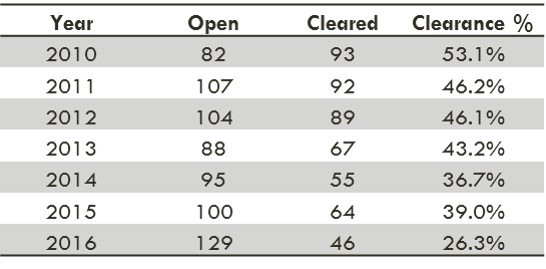One of the effects of a smaller police force has been a sizable drop in the number of officers assigned to NOPD’s homicide unit. As I previously showed, NOPD had 41 sworn officers assigned to homicide in mid-2013 and has only 29 officers assigned there as of this month.
Not all sworn officers assigned to the homicide unit are actual homicide detectives working cases. There’s also the unit’s leadership, several officers assigned to cold cases, and a couple of officers performing victim assistance roles. In 2013 there were 4 sergeants and 30 detectives specifically working new homicides. That was down to 3 sergeants and 19 officers as of March 2017, according to MAX.
The effect of the manpower drop on homicide clearance rates is clear. I took NOPD’s homicide spreadsheets (provided through public records request) for each year 2010 through 2016 and calculated the percent of murders in each year that were cleared by arrest or exception in that year. The result can be seen in the below table.
 The results are even more jarring when the age, race and gender of the victim are taken into consideration. Black males make up the vast majority of murder victims with 962 of 1,211 murder victims (79.4 percent) from 2010 to 2016 being black males. The clearance rate for black males, however, is typically much lower than the clearance rate for all other race/gender groups.
The results are even more jarring when the age, race and gender of the victim are taken into consideration. Black males make up the vast majority of murder victims with 962 of 1,211 murder victims (79.4 percent) from 2010 to 2016 being black males. The clearance rate for black males, however, is typically much lower than the clearance rate for all other race/gender groups.
The below table shows the clearance rates for a black male murder victim by age group with the overall black male clearance rate, the overall non black male clearance rate and the overall citywide rate below that.
 The correlation between manpower and clearance rates is predictably very strong. As these tables show, falling murder clearance rates is a major problem for New Orleans that desperately needs solving.
The correlation between manpower and clearance rates is predictably very strong. As these tables show, falling murder clearance rates is a major problem for New Orleans that desperately needs solving.
Leave a Reply